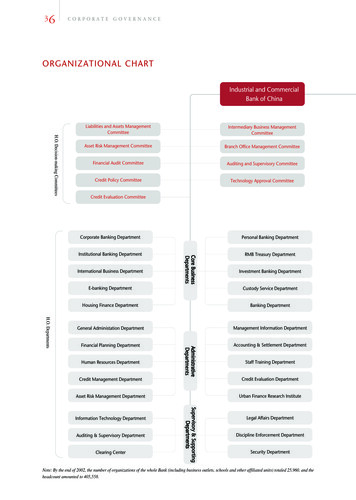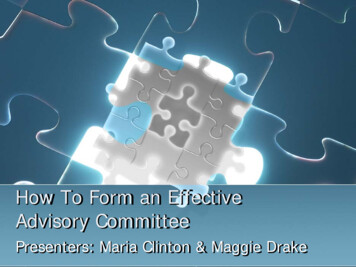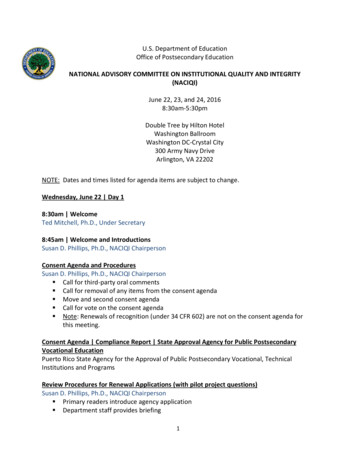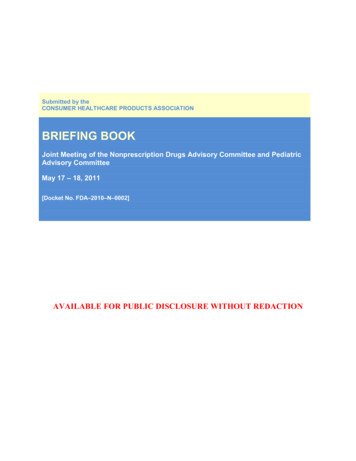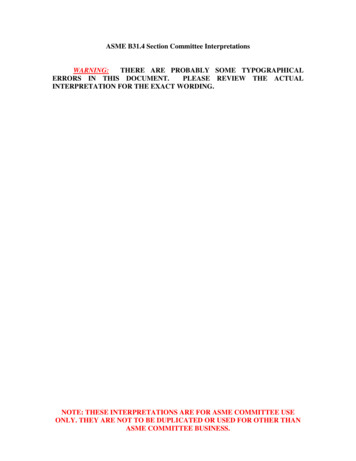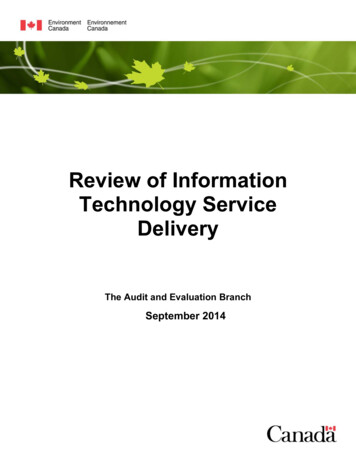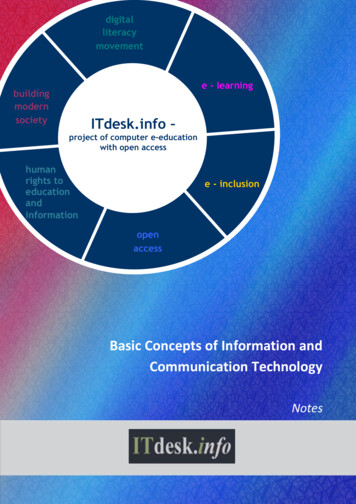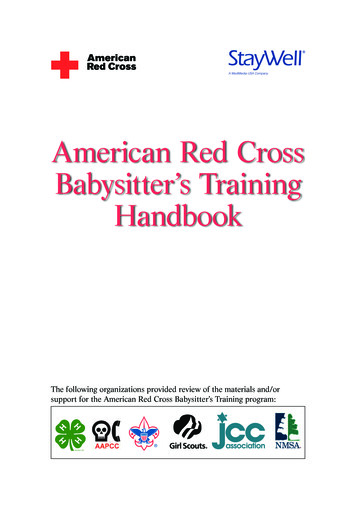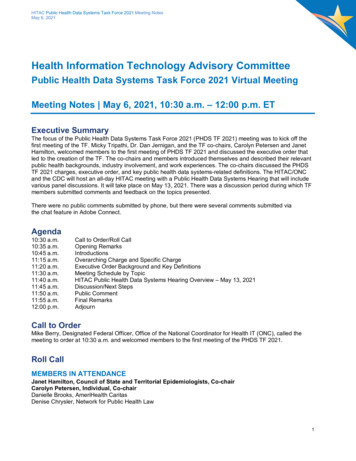
Transcription
HITAC Public Health Data Systems Task Force 2021 Meeting NotesMay 6, 2021Health Information Technology Advisory CommitteePublic Health Data Systems Task Force 2021 Virtual MeetingMeeting Notes May 6, 2021, 10:30 a.m. – 12:00 p.m. ETExecutive SummaryThe focus of the Public Health Data Systems Task Force 2021 (PHDS TF 2021) meeting was to kick off thefirst meeting of the TF. Micky Tripathi, Dr. Dan Jernigan, and the TF co-chairs, Carolyn Petersen and JanetHamilton, welcomed members to the first meeting of PHDS TF 2021 and discussed the executive order thatled to the creation of the TF. The co-chairs and members introduced themselves and described their relevantpublic health backgrounds, industry involvement, and work experiences. The co-chairs discussed the PHDSTF 2021 charges, executive order, and key public health data systems-related definitions. The HITAC/ONCand the CDC will host an all-day HITAC meeting with a Public Health Data Systems Hearing that will includevarious panel discussions. It will take place on May 13, 2021. There was a discussion period during which TFmembers submitted comments and feedback on the topics presented.There were no public comments submitted by phone, but there were several comments submitted viathe chat feature in Adobe Connect.Agenda10:30 a.m.10:35 a.m.10:45 a.m.11:15 a.m.11:20 a.m.11:30 a.m.11:40 a.m.11:45 a.m.11:50 a.m.11:55 a.m.12:00 p.m.Call to Order/Roll CallOpening RemarksIntroductionsOverarching Charge and Specific ChargeExecutive Order Background and Key DefinitionsMeeting Schedule by TopicHITAC Public Health Data Systems Hearing Overview – May 13, 2021Discussion/Next StepsPublic CommentFinal RemarksAdjournCall to OrderMike Berry, Designated Federal Officer, Office of the National Coordinator for Health IT (ONC), called themeeting to order at 10:30 a.m. and welcomed members to the first meeting of the PHDS TF 2021.Roll CallMEMBERS IN ATTENDANCEJanet Hamilton, Council of State and Territorial Epidemiologists, Co-chairCarolyn Petersen, Individual, Co-chairDanielle Brooks, AmeriHealth CaritasDenise Chrysler, Network for Public Health Law1
HITAC Public Health Data Systems Task Force 2021 Meeting NotesMay 6, 2021Jim Daniel, Amazon Web ServicesSteve Eichner, Texas Department of State Health ServicesNgozi Ezike, Illinois Department of Public HealthClaudia Grossmann, Patient-Centered Outcomes Research InstituteSteve Hinrichs, IndividualJim Jirjis, HCA HealthcareJohn Kansky, Indiana Health Information ExchangeBryant Karras, Washington State Department of HealthSteven Lane, Sutter HealthNell Lapres, EpicLes Lenert, Medical University of South CarolinaDenise Love, National Committee on Vital Health StatisticsArien Malec, Change HealthcareClem McDonald, National Library of MedicineAaron Miri, The University of Texas at Austin, Dell Medical School and UT Health AustinLarry Mole, Veterans Health AdministrationSheryl Turney, Anthem, Inc.MEMBERS NOT IN ATTENDANCEAbby Sears, OCHINONC STAFFMicky Tripathi, National Coordinator for Health ITMike Berry; Designated Federal OfficerBrett Andriesen, ONC Staff LeadBrenda Akinnagbe, ONC Staff LeadGeneral ThemesTOPIC: WELCOME, PHDS TF 2021 KICK-OFF, AND INTRODUCTIONSMicky Tripathi, Dr. Dan Jernigan, and the TF co-chairs, Carolyn Petersen and Janet Hamilton, welcomedmembers to the first meeting of PHDS TF 2021 and discussed the executive order that led to the creation ofthe TF. The co-chairs and members introduced themselves and described their relevant public healthbackgrounds, industry involvement, and work experiences.TOPIC: OVERVIEW OF PHDS TF 2021 CHARGES AND EXECUTIVE ORDER, & KEYDEFINITIONSThe co-chairs discussed the PHDS TF 2021 charges, executive order, and key public health data systemsrelated definitions.TOPIC: HITAC PUBLIC HEALTH DATA SYSTEMS HEARING OVERVIEWThe HITAC/ONC and the CDC will host an all-day HITAC meeting with a Public Health Data Systems Hearingthat will include various panel discussions. It will take place on May 13, 2021.TOPIC: DISCUSSION/NEXT STEPSThe co-chairs invited PHDS TF 2021 members to submit comments and feedback verbally or within the chatfeature in Adobe.Key Specific Points of DiscussionTOPIC: WELCOME, PHDS TF 2021 KICK-OFF, AND INTRODUCTIONSMicky Tripathi, the National Coordinator for Health IT welcomed members and explained that he co-chairs a2
HITAC Public Health Data Systems Task Force 2021 Meeting NotesMay 6, 2021joint work group with Dr. Dan Jernigan, Acting Deputy Director for Public Health Science and Surveillance,Centers for Disease Control and Prevention (CDC), to review public health data systems and their ability todetect and respond to COVID-19 and future public health threats, as required under an executive order thatPresident Joe Biden signed in January 2021. Interoperability was specifically called out in the executive order,so he explained it is important from a health IT perspective. Micky discussed how the work group will focus onmoving the current standard of public health data systems to a more dynamic healthcare ecosystem thatincludes public health (not siloed systems with static reporting). Next, Dr. Jernigan introduced himself anddescribed the roles he has held recently at the CDC and the National Response Coordination Center forCOVID-19 relief efforts. In his current role, he oversees the data modernization activities, funding strategies,and implementation work. He looks forward to addressing the executive order with the TF.Micky discussed how the COVID-19 pandemic tested the decentralized U.S. public health data system andadded that it has historically been under-resourced and not as connected or interactive as it could be in thefuture. The PHDS TF 2021 has the opportunity to examine gaps that were identified during the pandemic andto use funding that is now available to prepare the system to handle future public health crises better. Hethanked all members for joining the PHDS TF 2021.The PHDS TF 2021 co-chairs, Janet Hamilton and Carolyn Petersen, welcomed members. Carolyn explainedthat PHDS 2021 TF would be following up on the March 2020 meeting of the HITAC, during which presentersshared perspectives on the then emergent COVID-19 situation. The TF will discuss ways in which health ITcan continue to manage the pandemic and also how health IT can more efficiently and effectively work withclinicians to serve patients. Janet added that, though COVID-10 highlighted gaps in the public healthinfrastructure and for interoperability in health care, they preexisted the pandemic. The co-chairs introducedthemselves and invited all of the members present to introduce themselves and share any necessarydisclosures.INTRODUCTIONS: Carolyn has served as an advocate for patients after surviving pediatric cancer and is currentlySenior Editor for Mayo Clinic’s health information website. In addition, she served as a patientstakeholder reviewer for the Patient-Centered Outcomes Research Institute, a patient advocatefor the National Cancer Institute, and a consumer representative for an advisory panel at theFood and Drug Administration. She emphasized that, as a member of the TF, her viewsexpressed are personal and do not reflect the policy/position of Mayo Clinic. She is an unpaidmember of the HL7 International Board of Directors.Janet is the Executive Director of the Council of State and Territorial Epidemiologists (CSTE),representing the epidemiologists on the front line of the COVID-19 response at the state, local,tribal, and territorial levels. Previously, she worked as an epidemiologist for the FloridaDepartment of Health and led the disease surveillance activities and data systems, includingbacking policies.Danielle Brooks is the Director of Health Equity for the AmeriHealth Caritas family of companiesand is responsible for health equity development in the communities served by AmeriHealth.She works on improving data systems and leading COVID-19 outreach strategies for minoritypopulations, and she serves on the National Committee for Quality Assurance (NCQA) HealthEquity Committee. Previously, she served on the Patient Centered Outcome Research Institute(PCORI) Health Disparities Advisory Panel and as the AcademyHealth co-chair for Low ValueCare. She added that her views are her own and do not represent her company.Denise Chrysler directs the Network for Public Health Law’s Mid-States Region located at theUniversity of Michigan School of Public Health. She is a member of the National Committee ofVital Health and Statistics (NCVHS) and is a member of her local health board.Jim Daniel is the Public Health lead for State and Local Government at Amazon Web Services(AWS). Before joining AWS, he worked as Director of Public Health Innovation for the Office ofthe Chief Technology Officer and as the Public Health Coordinator for the Office of the NationalCoordinator for Health IT.3
HITAC Public Health Data Systems Task Force 2021 Meeting NotesMay 6, 2021 Steve Eichner is the Health Information Technology Lead at the Texas Department of StateHealth Services (DSHS), and he has worked to plan and implement health informationtechnology projects that improve the department’s ability to make data-informed decisions andincrease interoperability. He also serves as co-chair of the Public Health Task Force onPromoting Interoperability.Ngozi Ezike is the Director of the Illinois Department of Public Health and is a board-certifiedinternist and pediatrician who previously worked for the Cook County Department of PublicHealth (CCDPH).Claudia Grossmann is a Senior Program Officer with the Research Infrastructure team at thePatient-Centered Outcomes Research Institute (PCORI). She provides oversight for initiativesdesigned to strengthen community-driven research, including within PCORnet, the NationalPatient-Centered Clinical Research Network.Steve Hinrichs is the Chair of the Department of Pathology and Microbiology at the University ofNebraska Medical Center. He is board-certified in Anatomic and Clinical Pathology with a specialinterest in microbiology and emerging infectious diseases. He was previously the Director of theNebraska Public Health Laboratory and served as the Association of Public Health LaboratoryInformatics Committee chair. He is a member of the FDA Shield Initiative.Jim Jirjis is a board-certified internist and Chief Health Information Officer at HCA Healthcare.He was in charge of HCA’s Public and State Reporting before and during COVID. He is amember of the Sequoia Provider Subgroup.John Kansky is the President and CEO of the Indiana Health Information Exchange. He is on theboards of the Strategic Health Information Exchange Collaborative (SHIEC), the Consortium forState and Regional Interoperability (CSRI), and the Regenstrief Institute. He is the former CIOfor Marion County Health Department in Indiana, which includes Indianapolis.Bryant Karras is the Chief Informatics Officer and Senior Epidemiologist at the State ofWashington Department of Health. His current position is in the Office of Science Health andInformatics, where he guides the agency's interoperability work. He is a physician, an engineer,and public health informatician. He was formerly a Public Health Informatics faculty member atthe University of Washington and has roles in subcommittees/work groups in Council of Stateand Territorial Epidemiologists (CSTE), the Association of State and Territorial Health Officials(ASTHO), American Medical Informatics Association (AMIA) Public Health Informatics WorkingGroup, and previously served on the oversight committee for his state’s health informationexchange (HIE). He is a member of HL7’s Public Health Work Group.Steven Lane is a practicing primary care physician and clinical informaticist at Sutter Health inNorthern California and serves as Clinical Informatics Director for Privacy, Information Security &Interoperability. He has served on many task forces of the HITAC, and he is currently the cochair of the U.S. Core Data for Interoperability Task Force 2021 (USCDI TF 2021). He is thechair of the Sequoia Project, on the Carequality Steering Committee, and has roles within HL7,AMIA, and DirectTrust.Nell Lapres is an interface engineer and leads the COVID-19 Vaccination Interface ResponseTask Force at Epic. Nell represented Epic as a co-chair of the HL7 Public Health andEmergency Response workgroup for 2 years and participated in the workgroup for 3 years.Les Lenert is a primary care physician and is the Assistant Provost for Data Science andInformatics, Chief Research Information Officer, Professor of Internal Medicine, and SMARTState Chair in Healthcare Quality at the Medical University of South Carolina (MUSC). He is alsoVice President and Chief Medical Officer for Health Sciences South Carolina (HSSC) andAdjunct Professor of Computer Science and Engineering at the University of South Carolina. Hehas served on the HITAC for four years and was previously the founding Director of the NationalCenter for Public Health Informatics at the CDC.4
HITAC Public Health Data Systems Task Force 2021 Meeting NotesMay 6, 2021 Denise Love is a member of the National Committee on Vital Health Statistics (NCVHS) and isco-chair of the National Standards Committee. She has three decades of experience with publichealth data system development at the state and national levels. She was appointed as theDirector of the Office of Health Data Analysis at the Utah Department of Health and as ExecutiveSecretary of the Utah Health Data Committee, and then she served as the Executive Director ofthe National Association of Health Data Organizations (NAHDO) between 1999-2019. She alsoserved as co-chair and co-founder of the All Payer Claims Database Council (APCD).Arien Malec SVP, R&D Clinical and Administrative Networks for Change Healthcare, addresseshigh scale information exchange and improved care, improved health, and cost containmentthrough the use of clinical data. Before that role, he worked at the Office of the NationalCoordinator, as Coordinator for the Direct Project and the Standards and InteroperabilityFramework. Previously, he was VP, Product Management for RelayHealth.Clem McDonald is the Chief Health Data Standards Officer at the National Library of Medicine(NLM). Previously, he spent over 35 years at the Indiana University School of Medicine wherehe developed the Regenstrief Medical Record system, which was one of the first electronicmedical record systems in 1972, and he published the first randomized trials showing thebenefits of computer reminder systems and of physician order entry systems. He is involved withHL7, LOINC, the Unified Code for Units of Measure (UCUM), and other HITAC task forces.Aaron Miri is the Chief Information Officer for the University of Texas at Austin, Dell MedicalSchool and UT Health Austin. He discussed work UT Austin has done on the frontlines of theCOVID-19 pandemic relief efforts and as one of two vaccine hubs in Texas. He is also the cochair of the HITAC.Larry Mole is the Chief Officer of Population Health at the Veterans Health Administration, andhe oversees the following National programs: Health Equity, Health Solutions, LGBT Health,Health Promotion and Disease Prevention, Post Deployment Health, Public Health, and RuralHealth.Abby Sears is the Chief Executive Officer at OCHIN and is responsible for the overall strategyand executive leadership at OCHIN. She was not present at the meeting to share additionalintroductory information.Sheryl Turney is a Director within Anthem, Inc., where she is the enterprise subject matter expertin the area of health data sharing, health data use, APCD (All Payer Claims Data) strategy,policy & analytics. She has been a member of the HITAC for four years and has served onseveral HITAC task forces, including serving as co-chair of the Intersection of Clinical andAdministrative Data Task Force (ICAD TF). She serves on several APCD advisory and data usecommittees and is on the APCD Data Release Committee for Connie, a newly formed HealthInformation Alliance (HIA) for Connecticut. She works with HL7, CARIN, and others.Additional biography information for the TF members can be found c-health-data-systems-task-force-2021TOPIC: OVERVIEW OF PHDS TF 2021 CHARGES AND EXECUTIVE ORDER, & KEYDEFINITIONSCarolyn discussed the PHDS TF 2021 charges, which include: Overarching Charge: This Task Force will inform HHS’s response to President Biden’s ExecutiveOrder on Ensuring a Data-Driven Response to COVID-19 and Future High-Consequence PublicHealth Threats. Specific Charges: The PHDS Task Force shall:o Identify and prioritize policy and technical gaps associated with the effectiveness,interoperability, and connectivity of information systems relevant to public health. Thiswould include a focus on surveillance systems, infrastructure improvements, health equity,clinical engagement, research and innovation, educating and empowering individuals.5
HITAC Public Health Data Systems Task Force 2021 Meeting NotesMay 6, 2021oIdentify characteristics of an optimal future state for information systems relevant to publichealth and their use.Janet described the Executive Order on Ensuring a Data-Driven Response to COVID-19and Future High-Consequence Public Health Threats and highlighted Section 3. Public Health Data Systems,which stated that the Secretary of HHS, in consultation with the COVID-19 Response Coordinator and theheads of relevant agencies, shall promptly: (a) review the effectiveness, interoperability, and connectivity of public health data systemssupporting the detection of and response to high-consequence public health threats, such as theCOVID-19 pandemic; (b) review the collection of morbidity and mortality data by State, local, Tribal, and territorialgovernments during high-consequence public health threats, such as the COVID-19 pandemic;and (c) issue a report summarizing the findings of the reviews detailed in subsections (a) and (b) ofthis section and any recommendations for addressing areas for improvement identified in thereviews.Janet described the key definitions for the following terms: high-consequence public health threat,effectiveness, interoperability, and connectivity. These definitions were included on slides #7 and #8 of thepresentation materials. Also, she stated that a public health data system is defined as an informationtechnology system (or systems) used to collect, analyze, and disseminate health related data to monitor,assess, and improve the health of populations. She defined examples of traditional systems and discussed anexpanded view of public health data systems, in addition to non-traditional systems. Additional definitions andexamples were included on slide #9 of the presentation deck.TOPIC: PHDS TF 2021 MEETING SCHEDULEBrett Andriesen and Brenda Akinnagbe will be the ONC staff leads for the PHDS TF 2021, and theyintroduced themselves. Brett discussed the TF’s upcoming meeting schedule, which was broken down bytopic and was included on slides #10 and #11 in the presentation deck. He explained that the following topicswould be discussed at meetings with these themes: Public Health Surveillance (data standards, infrastructure, connecting/linking/sharing/integratingdata, health equity, surveillance systems, interoperability around situational awareness duringemergency responses, case reporting, testing, etc.) Public Health Information Infrastructure Improvements (preparedness, equity, performance,scalability, longitudinal tracking, data quality, policy, workforce gaps) Research Innovations (creating conditions that encourage innovations, stakeholderoutreach/engagement, open data access, data format and quality) Engaging and Empowering Individuals and Providers/Clinicians (ensuring good feedback loops)He noted that the schedule is subject to change, and an expanded timeline will be provided to TF members.The TF will present its final recommendations to the HITAC at its July 14, 2021 meeting.TOPIC: HITAC PUBLIC HEALTH DATA SYSTEMS HEARING OVERVIEWBrett explained that HHS/ONC and the CDC will host an all-day HITAC meeting with a Public Health DataSystems Hearing starting at 9:00 a.m. ET. It will include various panel discussions, and Brett listed some ofthe topics that would be covered. The finalized agenda will be made public shortly. The TF will examineissues raised during the hearing at a future meeting.TOPIC: DISCUSSION/NEXT STEPSThe co-chairs invited PHDS TF 2021 members to submit comments and feedback verbally or within the chat6
HITAC Public Health Data Systems Task Force 2021 Meeting NotesMay 6, 2021feature in Adobe. A public comment period will be held later in the meeting.DISCUSSION: Clem commented that defined coding or structure is necessary if data is being sentelectronically, even if it is narrative/text in formatting. Bryant emphasized Clem’s comment and discussed challenges related to the underfunding/lackof attention public health data systems have experienced over the years. He stated that theyoften have to revert to the lowest common denominator/legacy file formats instead of usingmodern standards with best practices. He hopes the TF can identify and makerecommendations for how public health can improve in these areas. Jim Daniel submitted two comments:o The specific types of public health data systems that will be discussed should be added tothe list of broad topics up for discussion at each meeting on the timeline. The TF shouldfocus on systems that were key to COVID responses (reporting and immunization systemsand surveillance) in addition to the broader topics.o A similar TF was held during Zika response efforts, and the recommendations it madearound electronic lab reporting, and complete data should be reviewed.o Carolyn will follow up with him for a copy of the previous TF’s recommendations. Arien commented that the timeframe is aggressive, so he suggested that this TF considerbreaking its work plan into two phases with a longer timeline. The TF should also examinefunding, operating, and incentives mechanisms that touch all stakeholders in the ecosystem. Hediscussed a specific example around how information was lost in a review of the lab reportingsystem. Sheryl discussed issues and inconsistencies she has encountered, as a payer, withimmunization registries across the U.S. Collecting this data and making it meaningful requires agreat amount of effort, and reporting the data is not always required. Identifiers are inconsistent,so using the data in a meaningful way can be difficult. Foundational work is needed, and the TFshould look into using other learnings from systems that have implemented additional tools (BillPay, etc.). Aaron shared several comments:o The PHDS TF 2021 should think about health equity by design as a key guide for its work.The National Coordinator has emphasized this idea.o He discussed work UT Austin has done on data around contact tracing, vaccination.o Public health workers are doing the best they can, and this is an opportunity to fix designand infrastructure issues (e.g., the continued use of fax machines).o He thanked everyone on the HITAC and other committees who have been workingtirelessly for the past year. Steven Lane submitted several comments, which included:o He is the USCDI TF 2021 co-chair and shared that, through many submissions for publichealth related data elements and classes were not included in the draft of Version 2 of theUSCDI (USCDI v2), the progress of the USCDI work is largely driven by stakeholder input.He invited PHDS TF 2021 members to comment on and support elements in the ONC NewData Element and Class (ONDEC) submission system to make the process more robust.o The Pew Charitable Trusts sponsored a series of webinars on public health topics anddeveloped draft policy suggestions that the TF should review. Janet was involved in thiswork.o There is a need to focus on clinical data and integrating relevant data into clinicalworkflows. There are opportunities to work on supporting and scaling up the bidirectionalexchange of clinical data, including those that were piloted during the pandemic.7
HITAC Public Health Data Systems Task Force 2021 Meeting NotesMay 6, 2021o The TF has an opportunity to leverage existing interoperability tools and efforts, includingthe Directed Exchange methodology, Query-Based Document Exchange, and HL7’s FastHealthcare Interoperability Resources (FHIR ).Denise L. commented that the TF should discuss governance, the need for broader use cases,and linkage between traditional and non-traditional data systems to fill gaps. Designing dataexchange across the ecosystem to broaden access will be important.Danielle voiced her agreement with the others’ comments and echoed Aaron’s statement thatthe TF should focus on health equity by design. She described the challenges of effectivelyusing demographic data due to the ways in which it is currently classified and bucketed. The TFshould examine these issues and also focus on other elements that can be incorporated,including language, disability, and sexual and other gender identification (SOGI) data.Steve Hinrichs commented that the TF should look into how building blocks that have alreadybeen developed (USCDI, HIEs, TEFCA) can be used to serve public health data needs, likesharing data between payers and providers while addressing the privacy concerns of patients.Les commented that the TF should focus on how to best use the resources/funding for publichealth and infrastructure, informatics, data exchange, and syndromic surveillance to make amore equitable system that can work in an ecologically sound manner with the clinical caresystem to care for the population of the U.S. The TF must consider the diversity in public healthdelivery systems, clinical healthcare delivery, and clinical population health services anddetermine how to bring them together to optimize public health. He cautioned the TF that theapproach they create should create a level playing field for public health departments and notfocus on one given standard/approach. The design should be able to grow.John responded to the comments Steven Lane and Steve Eichner made earlier about buildingon and better integrating public health infrastructure and systems. He stated that HIEs are readydata assets and data plumbing assets that demonstrated their usefulness during the pandemic.The TF should look at HIE outcomes/experiences across states and territories and considermaking recommendations around how to make them work together via readiness of operabilityand policy solutions.Nell echoed other TF members’ comments about breaking down silos in the ecosystem andallowing for better exchanges of data between healthcare organizations and public health toimprove patient care. The TF should focus on the scalability of the exchange of data for the longterm success of the project.Jim Jirjis commented that there are costs/waste associated with providers interacting with publichealth, so there should be an onramp approach (similar to TEFCA, possibly using anintermediary) to make technologies and processes more streamlined.Action ItemsAs their next steps, the PHDS TF 2021 will: Review document that will be circulated by the co-chairs and prepare comments for discussion, Identify gaps but also focus on the idea of meaningful recommendations, Share any prior work materials (mentioned during the meeting and additional) with the co-chairsfor circulation to all TF members, Keep the rigorous meeting schedule in mind and be prepared for meeting times/the meetingschedule to be extended, given the importance of the TF’s work.The TF co-chairs and the ONC team will create and share a Google document with all members to addresskey questions and topic areas to set the stage for future meetings following the HITAC hearing.8
HITAC Public Health Data Systems Task Force 2021 Meeting NotesMay 6, 2021Public CommentQUESTIONS AND COMMENTS RECEIVED VIA PHONEThere were no public comments received via phone.QUESTIONS AND COMMENTS RECEIVED VIA ADOBE CONNECTMike Berry (ONC): Welcome to the kick-off of the Public Health Data Systems Task Force. We will be startingsoon.Jim Jirjis: Jim JirjisLeslie A Lenert: waiting to get onAaron Miri: @John Kansky - Guitar riff request - Stairway to Heaven:-)John Kansky: yeh.noJohn Kansky: Dr Karras. I'm IJohn Kansky: Dr Karras. I'm a bioengineering grad from UWLarry Mole - VA: Hi. I am on but can't seem to open my mikeLarry Mole - VA: mic :-)Aaron Miri: Sorry I forgot to state, I am the co-chair of the hitac. And i serve as a member of the board ofdirectors with The Sequoia Project, Commonwell Health Aliiance [sic]Arien Malec: I'm on late :-(Aaron Miri: Welcome Arien!Carolyn Petersen: Welcome, Arien. We'll circle back to you for an Intro just before Public Comment.Larry Mole - VA: And I am on as well.Bryant thomas Karras MD: agreed!Aaron Miri: @bryant - I would be happy with CSV. I've had to explain to some groups how not to rely on faxmachines :-( especially for sharing case dataBryant thomas Karras MD: @arron didn’t want to make the delta seem unattainableCarolyn Petersen: Thanks, Larry. We look forward to your Intro, too.Jim Jirjis: here here. Was going to mention concern that we address funding for public health departments(and other participants in the ecosystem), as well as incentive for them to align to not only techincal [sic]specification, but also processesJim Daniel: We need to also remember that besides the technology stack, we need to think about policyissues. Remember one of the main barriers with ELR (especially results coming from national labs) has beenpublic health does not receive the demographic information needed to start a case investigation. There arecurrently no national policy levers to address this gap.9
HITAC Public Health Data Systems Task Force 2021 Meeting NotesMay 6, 2021cle
May 06, 2021 · expressed are personal and do not reflect the policy/position of Mayo Clinic. She is an unpaid member of the HL7 International Board of Directors. Janet is the Executive Director of the Council of State and Territorial Epidemiologists (CSTE), representing the epidemiologists on the
